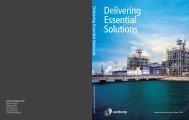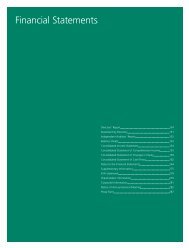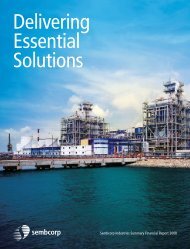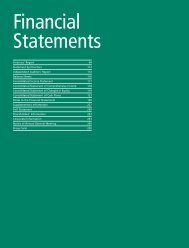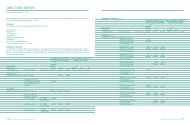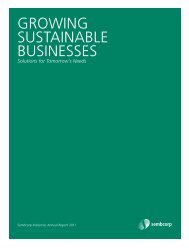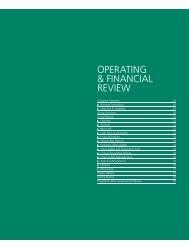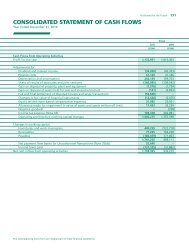FINANCIAL STATEMENTS (Full Version) - Sembcorp
FINANCIAL STATEMENTS (Full Version) - Sembcorp
FINANCIAL STATEMENTS (Full Version) - Sembcorp
Create successful ePaper yourself
Turn your PDF publications into a flip-book with our unique Google optimized e-Paper software.
Notes to the<br />
Financial Statements<br />
Year Ended December 31, 2008<br />
2. SUMMARY OF SIGNIFICANT ACCOUNTING POLICIES (cont’d)<br />
q. Employee Benefits (cont’d)<br />
ii. Defined Benefit Plans (cont’d)<br />
Actuarial gains and losses arise mainly from changes in actuarial assumptions and differences between<br />
actuarial assumptions and what has actually occurred. They are recognised in the income statement, over the<br />
expected average remaining working lives of the employees participating in the plan, only to the extent that<br />
their cumulative amount exceeds 10% of the greater of the present value of the obligation and of the fair<br />
value of plan assets. Unrecognised actuarial gains and losses are reflected in the balance sheet.<br />
For defined benefit plans, the actuarial cost charged to the income statement consists of current service cost,<br />
interest cost, expected return on plan assets and past service cost as well as actuarial gains or losses to the<br />
extent that they are recognised. The past service cost for the enhancement of pension benefits is accounted<br />
for when such benefit vests or becomes a constructive obligation.<br />
Where the calculation results in a benefit to the Group, the recognised asset is limited to the net total of any<br />
unrecognised actuarial losses and past service costs and the present value of any future refunds from the plan<br />
or reductions in future contributions to the plan.<br />
iii. Short-Term Employee Benefits<br />
Short-term employee benefit obligations are measured on an undiscounted basis and are expensed as the<br />
related employment service is provided.<br />
The amount expected to be paid are accrued when the Group has a present legal or constructive obligation<br />
to pay this amount as a result of past service provided by the employee and the obligation can be estimated<br />
reliably.<br />
iv. Staff Retirement Benefits<br />
Retirement benefits payable to certain categories of employees upon their retirement are provided for in<br />
the financial statements based on their entitlement under the staff retirement benefit plan or, in respect of<br />
unionised employees of a subsidiary who joined on or before December 31, 1988, based on an agreement with<br />
the union.<br />
The Group’s net obligation in respect of retirement benefits is the amount of future benefit that employees<br />
have earned in return for their service in the current and prior periods. The obligation is calculated using the<br />
projected future salary increase and is discounted to its present value and the fair value of any related assets<br />
is deducted.<br />
v. Equity and Equity-Related Compensation Benefits<br />
Share Option Plan<br />
The share option programme allows the Group’s employees to acquire shares of the Group companies.<br />
The fair value is measured at grant date and spread over the period during which the employees become<br />
unconditionally entitled to the options. The fair value of options granted is recognised as an employee<br />
expense with a corresponding increase in equity. At each balance sheet date, the Company revises its estimates<br />
of the number of options that are expected to become exercisable. It recognises the impact of the revision<br />
of original estimates in employee expense and in a corresponding adjustment to equity over the remaining<br />
vesting period.<br />
The proceeds received net of any directly attributable transaction costs are credited to share capital when the<br />
options are exercised.<br />
2. SUMMARY OF SIGNIFICANT ACCOUNTING POLICIES (cont’d)<br />
q. Employee Benefits (cont’d)<br />
v. Equity and Equity-Related Compensation Benefits (cont’d)<br />
Performance Share Plan<br />
The fair value of equity-related compensation is measured using the Monte Carlo simulation method as at<br />
the date of the grant. The method involves projecting future outcomes using statistical distributions of key<br />
random variables including share prices and volatility of returns.<br />
In estimating the fair value of the compensation cost, market-based performance conditions are taken<br />
into account. Therefore, for performance share grants with market-based performance conditions, the<br />
compensation cost is charged to the income statement with a corresponding increase in equity on a basis that<br />
fairly reflects the manner in which the benefits will accrue to the employee under the plan over the service<br />
period to which the performance period relates, irrespective of whether this performance condition is satisfied.<br />
Restricted Stock Plan<br />
Similar to the Performance Share Plan, the fair value of equity related compensation is measured using the<br />
Monte Carlo simulation method as at the date of the grant. The method involves projecting future outcomes<br />
using statistical distributions of key random variables including share prices and volatility of returns. This<br />
model takes into the account the probability of achieving the performance conditions in the future.<br />
The fair value of the compensation cost is measured at grant date and spread over the service period to which<br />
the performance criteria relates and the period during which the employees become unconditionally entitled<br />
to the shares. The compensation cost is charged to the income statement with a corresponding increase in<br />
equity on a basis that fairly reflects the manner in which the benefits will accrue irrespective of whether this<br />
performance condition is satisfied.<br />
At the balance sheet date, the Company revises its estimates of the number of performance-based restricted<br />
stocks that the employees are expected to receive based on the achievement of non-market performance<br />
conditions and the number of shares ultimately given. It recognises the impact of the revision of the original<br />
estimates in employee expense and in a corresponding adjustment to equity over the remaining vesting period.<br />
In the Company’s separate financial statements, the fair value of options, performance shares and restricted<br />
stocks granted to employees of its subsidiaries is recognised as an increase in the cost of the Company’s<br />
investment in subsidiaries, with a corresponding increase in equity over the vesting period.<br />
vi. Cash-Related Compensation Benefits<br />
<strong>Sembcorp</strong> Challenge Bonus<br />
The Group recognises a liability and an expense for bonuses and profit-sharing, based on a formula that<br />
takes into consideration the share price of the Company. The Group recognises a provision when contractually<br />
obliged to pay or where there is a past practice that has created a constructive obligation to pay.<br />
The compensation cost is measured at the fair value of the liability at each balance sheet date and spread<br />
over the service period to which the performance criteria relates and the period during which the employees<br />
become unconditionally entitled to the bonus. The liability takes into account the probability of achieving the<br />
performance conditions in the future.<br />
Until the liability is settled, the Group will re-measure the fair value of the liability at each balance sheet date<br />
and at the date of settlement, with any changes in fair value recognised in the income statement for the period.<br />
132 Delivering Essential Solutions <strong>Sembcorp</strong> Industries Annual Report 2008 133



